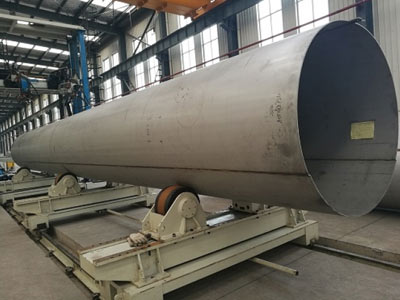
Stainless steel refers to a broad family of alloys, all containing approximately 10 to 30 percent chromium. Prized for its resistance to corrosion and oxidation, stainless steel is covered by an inert, chromium-rich oxide layer that protects the metal underneath. Stainless steel’s corrosion resistant properties come from this invisible, inert chromium layer, which allows the metal to ‘self-repair’. When stainless steel is damaged mechanically or chemically, a new chromium oxide layer is formed which protects the steel underneath (as long as oxygen is present, even in very small amounts).
 Triton Pipes gun drilling experience includes a wide variety of precision stainless steel tubing, including 300 and 400 series stainless steels, 17-4 PH and 17-7 PH stainless steels as well as other nickel-based alloys. When projects require custom precision stainless steel tubing in difficult to find ID sizes, Triton Pipes is the ideal source for industry leading, tight tolerance solutions.
Triton Pipes gun drilling experience includes a wide variety of precision stainless steel tubing, including 300 and 400 series stainless steels, 17-4 PH and 17-7 PH stainless steels as well as other nickel-based alloys. When projects require custom precision stainless steel tubing in difficult to find ID sizes, Triton Pipes is the ideal source for industry leading, tight tolerance solutions.
Stainless steel’s many positive characteristics include: ductility; malleability; oxidation and corrosion resistance; resistance to pitting at crevices; magnetic characteristics; resistance to cracking at extreme temperatures; hygienic properties, and ease of fabrication. Each characteristic depends on what elements are added to the steel and in what proportions.
For example, nickel is often used to strengthen the oxide layer, and makes stainless nonmagnetic, while the addition of nitrogen improves the final product’s ductility. In general, stainless steels with the highest proportion of chromium ultimately have the strongest corrosion resistance.
Stainless steel is commonly alloyed with a number of elements including aluminum, copper, nickel, titanium and molybdenum in order to enhance certain physical properties and performance characteristics in high stress, high stakes environments. Triton Pipes regularly collaborates with engineers in aerospace, medical, nuclear power and industrial sectors to machine stainless steel tubular products to meet stringent design specifications and extreme depth to ID ratios.
Three broad categories make up the family of stainless steel alloys: ferritic, martensitic and austenitic stainless steels.
Ferritic steels contain 10.5 to 27 percent chromium, are nickel free and magnetic. They have modest anticorrosion properties, and are often employed in automotive and architectural applications when reduced weight and high tensile strength are critical safety and cost saving considerations.
Martensitic steels have modest corrosion resistance, and typically contain 11.5 to 18 percent chromium and up to 1.2 percent carbon. They are nonmagnetic, and ideal for the manufacture of surgical instruments, tools and power generation components.
Austenitic steels are also nonmagnetic, and contain 16 to 26 percent chromium and up to 35 percent nickel. They typically have the highest corrosion resistance of the three families. Often found in the aerospace and food and beverage industries, austenitic stainless steel is one of the most commonly used stainless alloys (including grade 304, which is 18 percent chromium and 8 percent nickel).